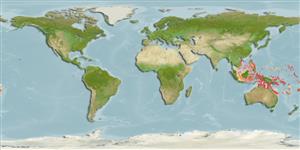>
Gobiiformes (Gobies) >
Gobiidae (Gobies) > Gobiinae
Etymology: Signigobius: Name from Latin, signus for mark and gobius for a genus of fish, referring to its distinctive coloration.; biocellatus: Name from Latin bi meaning two and ocellatus for small eye spots, referring to the 2 prominent ocellated spots on the dorsal fins..
More on authors: Hoese & Allen.
Environment: milieu / climate zone / depth range / distribution range
Sinh thái học
Biển Cùng sống ở rạn san hô; Mức độ sâu 1 - 30 m (Ref. 1602), usually 2 - 30 m (Ref. 27115). Tropical; 22°C - 27°C (Ref. 27115); 19°N - 24°S
Western Pacific: Philippines to the Solomon Islands and Vanuatu, south to the southern Great Barrier Reef; Palau in Micronesia.
Bộ gần gũi / Khối lượng (Trọng lượng) / Age
Maturity: Lm ? range ? - ? cm
Max length : 10.0 cm SL con đực/không giới tính; (Ref. 48637)
Các tia vây lưng cứng (tổng cộng) : 7; Các vây lưng mềm (tổng cộng) : 10 - 11; Tia cứng vây hậu môn: 1; Tia mềm vây hậu môn: 10 - 11. Conspicuous ocellated dorsal fins (Ref. 90102); characterized by pale bluish grey to yellowish tan; narrow brown bar below eye; upper half of body with irregular brown spot and saddles; three irregular brown bars on lower half of body; narrow brown bar across base of caudal fin; pelvic and anal fins black with blue spots; rounded caudal fin; longitudinal scale series 48-55; mainly ctenoid body scales posteriorly, becoming cycloid anteriorly just behind pectoral base and below first dorsal fin; cycloid on ventral surface of abdomen; head and midline of nape without scales; depth of body 4.3-5.6 in SL (Ref. 90102).
Adults occur in sandy to silty bottoms of lagoons and coastal bays near coral, rubble or leaf litter shelter. Solitary or in pairs that share sandy burrows (Ref. 90102). Feed on small interstitial invertebrates by sifting mouthfuls of sand. Monogamous (Ref. 52884, 48637).
Life cycle and mating behavior
Maturities | Sự tái sinh sản | Spawnings | Egg(s) | Fecundities | Ấu trùng
Monogamous mating is observed as both obligate and social (Ref. 52884).
Allen, G.R. and R. Swainston, 1992. Reef fishes of New Guinea: a field guide for divers, anglers and naturalists. Publication No. 8. Christensen Research Institute, Madang, Papua New Guinea. 132 p. (Ref. 6023)
IUCN Red List Status (Ref. 130435)
Threat to humans
Harmless
Human uses
Các nghề cá: không ích lợi (thú vị); Bể nuôi cá: Tính thương mại
Các công cụ
Special reports
Download XML
Các nguồn internet
Estimates based on models
Preferred temperature (Ref.
123201): 25.8 - 28.9, mean 27.7 °C (based on 350 cells).
Phylogenetic diversity index (Ref.
82804): PD
50 = 1.0000 [Uniqueness, from 0.5 = low to 2.0 = high].
Bayesian length-weight: a=0.01023 (0.00477 - 0.02194), b=3.02 (2.84 - 3.20), in cm total length, based on LWR estimates for this (Sub)family-body shape (Ref.
93245).
Mức dinh dưỡng (Ref.
69278): 3.5 ±0.37 se; based on food items.
Thích nghi nhanh (Ref.
120179): Chiêù cao, thời gian nhân đôi của chủng quần tối thiểu là dưới 15 tháng (Preliminary K or Fecundity.).
Fishing Vulnerability (Ref.
59153): Low vulnerability (10 of 100).
Nutrients (Ref.
124155): Calcium = 108 [58, 218] mg/100g; Iron = 0.771 [0.403, 1.406] mg/100g; Protein = 18.5 [16.7, 20.2] %; Omega3 = 0.157 [0.071, 0.270] g/100g; Selenium = 21.2 [11.4, 41.4] μg/100g; VitaminA = 149 [43, 452] μg/100g; Zinc = 1.79 [1.21, 2.64] mg/100g (wet weight);
